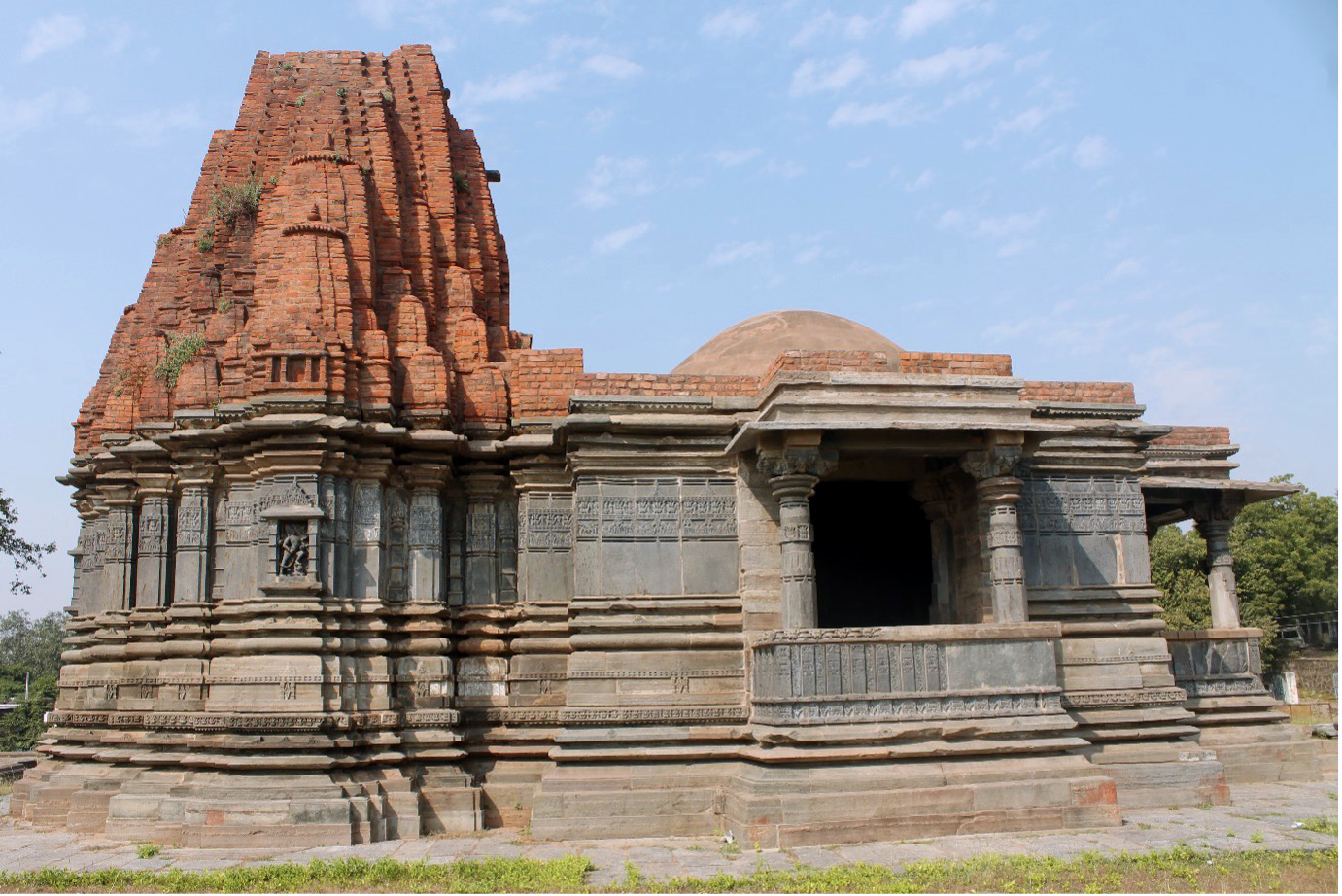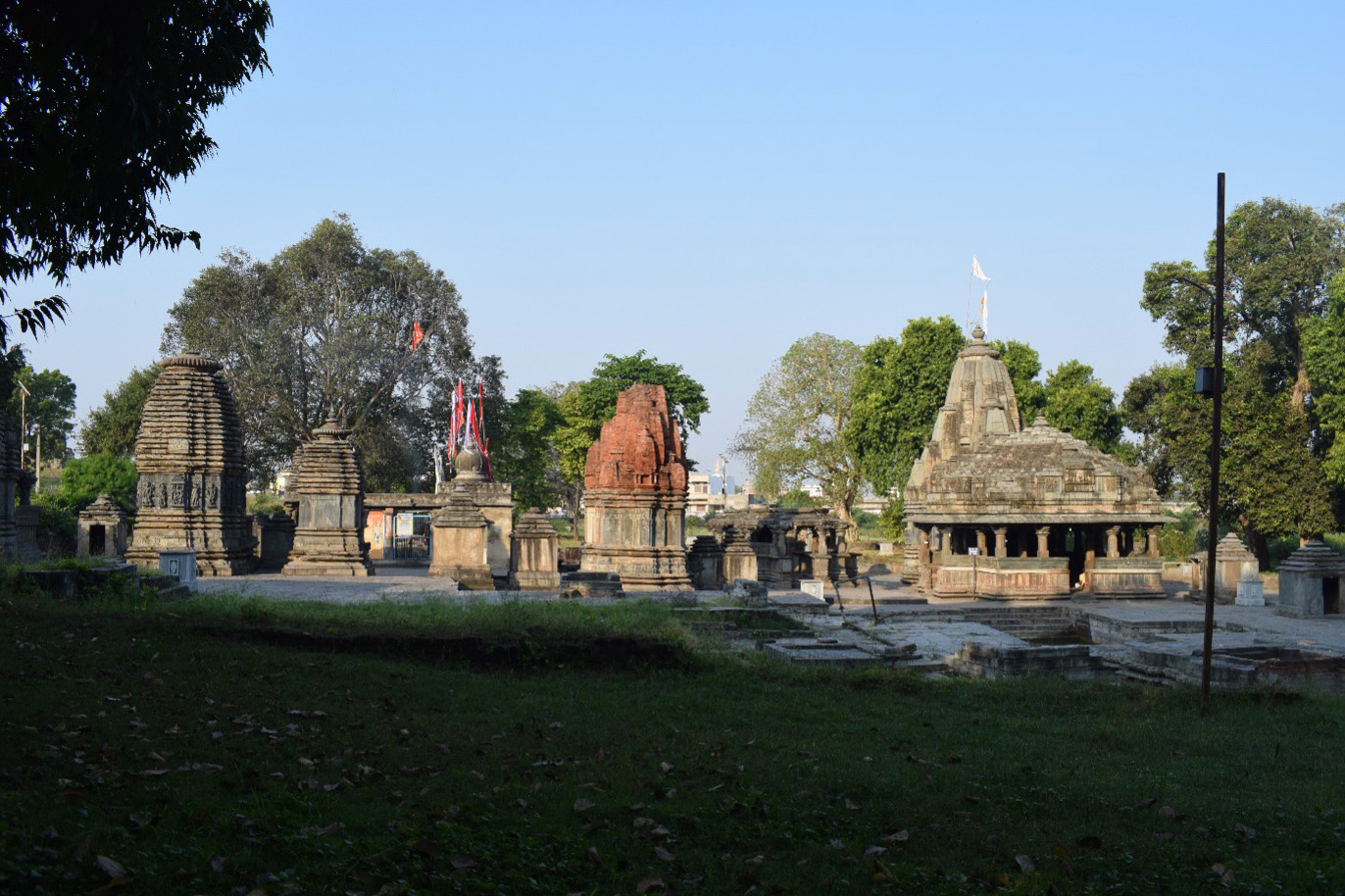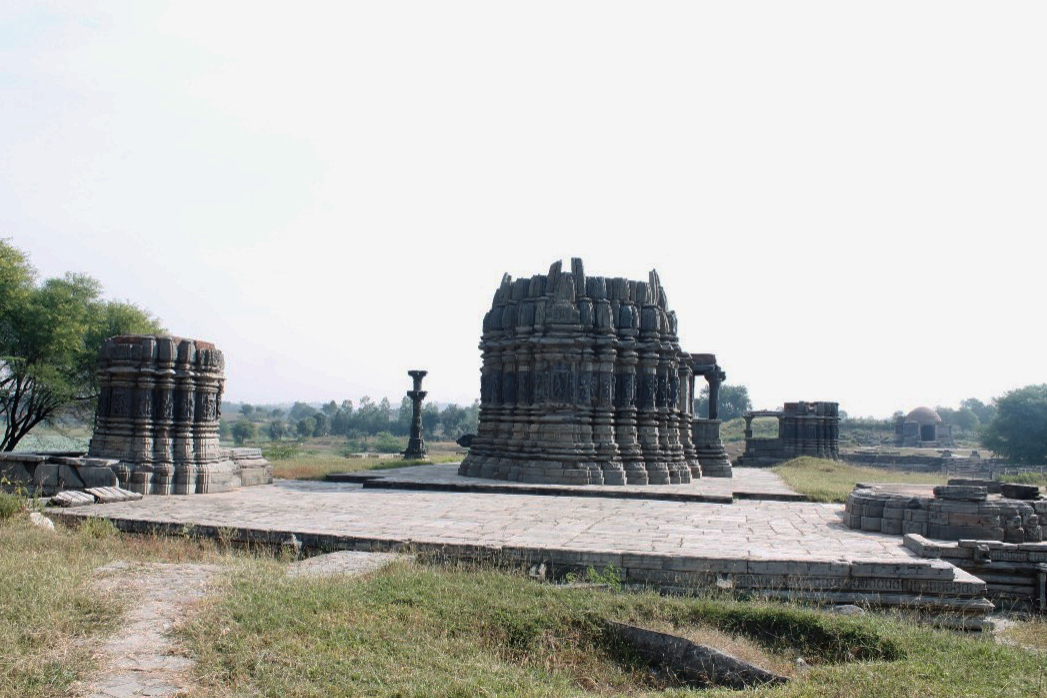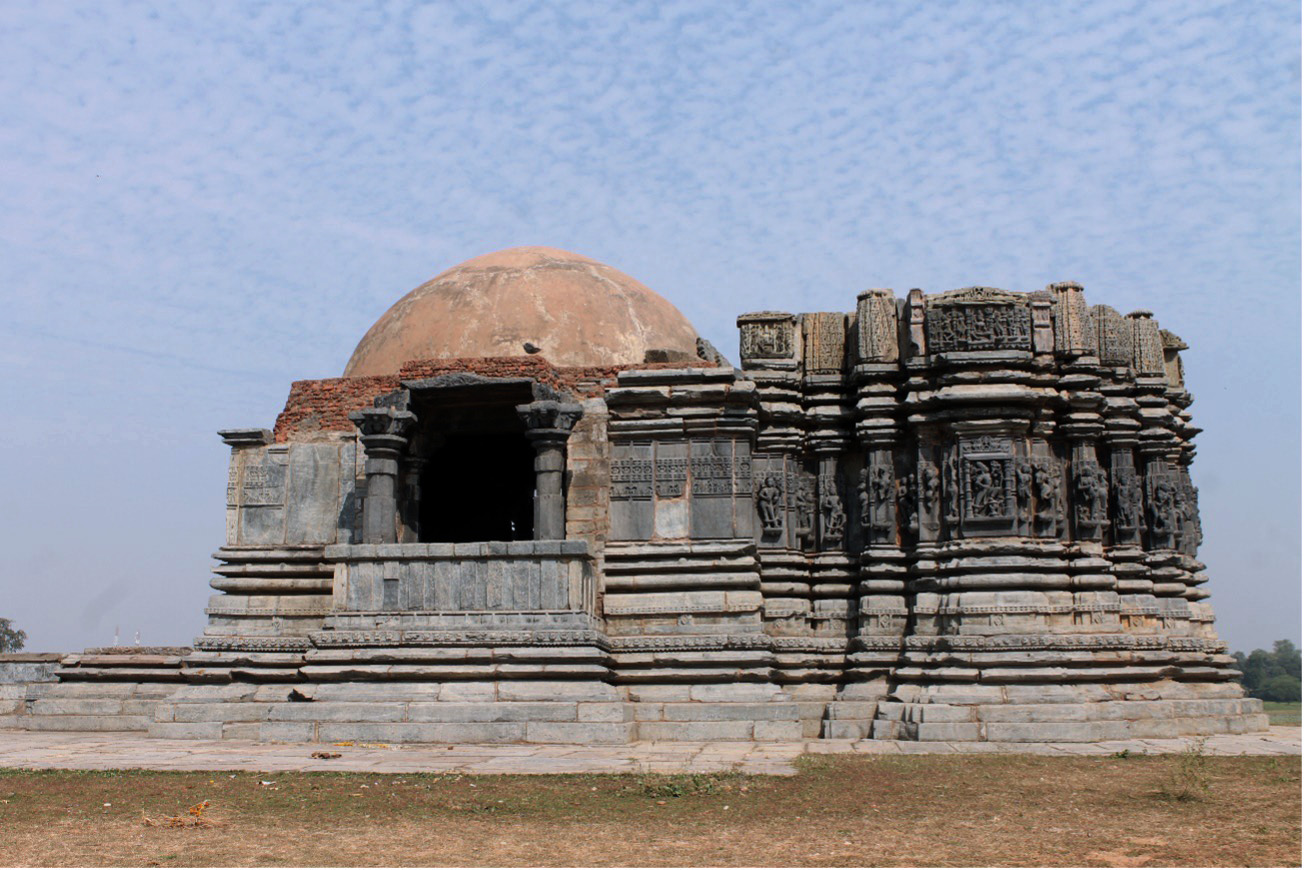Temples at Arthuna: Architecture from the medieval Vagada region
By Swapna Joshi
The historic Vagada region corresponds to the modern geographical areas of southern Rajasthan, especially the Dungarpur and Banswara districts. This region is home to several notable temples, including the Tripura Sundari Temple at Dungarpur, the Brahma Temple at Chinch, the Sambhavnath Jain Temple at Talwara, the Shiva Temple at Paraheda (Panaheda), and the Shiv and Jain temples at Arthuna. [1] Arthuna is located in the present-day Banswara district of Rajasthan, on the banks of the River Mahi and its tributary River Anas. The town of Arthuna has several architectural vestiges that boast the region from the medieval period. During their rule, the Paramaras commissioned the majority of the temples and tanks, specifically in the eleventh to twelfth centuries CE. It once served as a vital political hub for the Paramaras of Vagada. Seven inscriptions of the Paramaras have been found at Arthuna, of which five inscriptions are from the time of Paramara Chamundaraja and two are from the time of Paramara Vijayraja. The inscriptions, which are in Sanskrit and written using Devanagari script, praise the Paramaras and mention their genealogies. They also document temple construction, image consecration, and land donation to Brahmanas. The Government Museum in Ajmer, Rajasthan, stores other inscriptions, except for the one in the Mandaleshwar Temple.
The ancient names of this town that appear in the Paramaras' historical records are Utthupanaka, Uthunaka, and Arathunaka. For instance, the inscriptions from the reign of Paramara king Chamundaraja mention Utthapanaka or Uthunaka as a place name, identifying it with the present-day Arthuna. [3] The little-known Paramara family, who ruled Vagada (literally means a forest) [4], were an offshoot of the imperial Paramaras of Malwa and had their capital at Dhar, situated in the present-day state of Madhya Pradesh. The heydays of their rule were during the eleventh-twelfth century CE. Another important branch of the Paramaras was at Arbuda (Mount Abu), with Chandravati serving as their political seat, also known as Chandroti, a village near Abu Road in Rajasthan. Legends attribute the mythical birth of the Paramaras to a sacred fire on Mount Abu, which is revered as a place of sanctity. The story narrates how Sage Vishvamitra stole a wish-granting cow from Sage Vashishtha. Hence, the latter made special offerings to the sacrificial pit, following which a hero reacquired the cow and earned the name Paramara. [5] There are some variations of this story, but most texts and inscriptions have similar interpretations, including the Arthuna inscription of Chamundaraja. [6]
Arthuna's lesser-known yet rich architectural heritage consists of eight large temples and temple complexes, as well as several architectural remains that highlight the region's historical exuberance. This large corpus of visual art bears testimony to the thriving settlement that the Vagada region witnessed through medieval times. The temples at Arthuna are situated to the east of the modern settlement, dispersed along a natural lake known as the Gamela Talav (natural lake). From the wall remains found to the southeast of all the temple structures, it is evident that Arthuna was a fortified settlement during the medieval period. Scholars have struggled to precisely define the boundaries and extent of this fortification, but they have traced the remaining portions of the ancient fortification based on the ancient brick wall revealed during the River Mahi project.

All the temples within Arthuna are built in stone. While the temple's main fabric is sandstone, the images on the exterior walls of some temples, such as the Someshwar Mahadev and Kumbheshwar Mahadev temples, are made of a variety of granite stone. The contrast between the yellow sandstone and greenish-black granite gives an interesting colour tone to the temples. The temples' stylistic features conform to the architectural styles of the Maha-Maru, Maha-Gurjara, and Maru-Gurjara temples. An eminent scholar of temple architecture, the Late Prof. M.A. Dhaky, identified and labeled these styles of temple architecture based on the distinct features of the temples. This includes the ground plan, temple elevation, and decorative motifs on the temple walls. Dhaky opines that Vagada ‘pauses on a trijunction of Malwa, Mewad, and Gujarat’, the regions that influenced the aforementioned architectural styles. [7] As a result, artistic influences from all the neighbouring regions have contributed to the architecture in Arthuna. The salient features of select temples are briefly enumerated here.
Mandaleshwar Mahadeva Temple
Known locally as the Mandaleshwar Mahadev Ka Mandir, this temple honors Shiva and stands slightly apart from the other temples in the complex, close to the Arthuna village bus stand. With an inscription that mentions the patronisation of the temple during the reign of Paramara King Chamundaraja, this is one of the few temples in Arthuna that has a laudatory epigraphical record in its name. At first glance, it might appear as a lone standing temple, but a closer look reveals that the high jagati (raised platform) on which the temple stands today likely had ancillary structures as well. Only the foundation walls remain intact, making it challenging to determine if these structures predate the main temple. The temple faces eastward. The plan consists of a garbhagriha (sanctum sanctorum), antarala (antechamber), sabhamandapa (semi-open hall) with lateral transepts, and a mukhamandapa (porch). The saptaratha mulaprasada (temple proper exterior with seven projections on each side) has projections and recesses in the form of bhadras (principal projection), karnas (corner projection), and nandikas (intermediate projection). The temple's base has various mouldings, including the graaspatti (band of kirtimukhas), kumbha (pitcher), and kani (conical-shaped moulding), all of which are simple in design and not ornate. The temple's exterior walls only have images in the three principal niches facing the cardinal directions. The west-facing wall features the image of Natesha, the north-facing niche features Chamunda, and the south-facing wall displays the image of Andhakasuravadha. The other projections on the walls are carved with geometric designs, while the recesses are adorned with kutasthambhas, which are motifs of small miniature models of temple spires surmounted on pilasters. This is a notable feature of the temple, a feature commonly found in temples of the Malwa region but not commonly seen in temples in Arthuna. The temple's original shikhara (spire) is no longer visible. Composed of stone, it must have been of the multi-spired shekhari variety.
The temple interior is also relatively plain. One of the most interesting aspects is the depiction of the sutradhara on the pillar shaft of the sabhamandapa. Sutradhara architects designed and supervised the construction of a temple. The image here is shown holding a yardstick and hence has been identified as probably of the architect who was instrumental in building the temple. The temple's ceiling consists of concentric circles. The garbhagriha enshrines an image of a goddess, presumably Parvati.
The temple's dating is critical not only for this structure, but also for several other temples within Arthuna. The temple contains a eulogy inscription stating that Paramara Vagada King Chamundaraja, under the name Mandalesha, laid the foundation of this Shiva Temple in the year 1080 CE. [8] Scholars have debated the contemporaneity of the temple and the inscription, but largely agree that the temple dates to the late eleventh century CE. [9]
As previously stated, in the present settlement, the Mandaleshwar Mahadev Temple is slightly isolated from other Arthuna temples. We shall now discuss the other temples in order of their appearance, starting from the Hanuman Garhi Temple complex, which is the largest within Arthuna.
Hanuman Garhi Temple Complex
The Hanuman Garhi Temple Complex is Arthuna's largest, most vibrant, and most highly visited temple complex. The complex acquires its name from a colossal Hanuman statue enshrined here, dating to 1107 CE during Paramara King Vijayaraja’s rule in Vagada. [10]
The complex's architecture is characterized by two large temples, Neelkanth Mahadev Temple and Kumbheshwar Temple, Hanuman Temple, over a dozen smaller shrines, a Surya Kund (water tank), and numerous architectural and sculptural remains all located within the ancient prakara (compound wall). Almost all of the temples have an entrance gateway to the west. The Neelkanth Mahadev Temple is the most lofty, drawing several affinities with other Shaiva shrines within Arthuna, such as the Someshwar Mahadev and Kumbheshwar Mahadev temples. The main temple consists of a saptaratha mulaprasada, This mandapa (hall) is distinguished by its kakshasana, a balcony-like feature with low seatbacks, and its dwarf walls, which feature ornamentation and figural depictions on the exterior. and a sabhamandapa. The distinctive feature of this mandapa (hall) is the kakshasana (balcony-like feature with low seatbacks) with dwarf walls containing ornamentation and figural depictions on the This temple's garbhagriha is lower than the mandapa, which is at a surface level.principal niches, only the Lakulisha image in the southern niche is still in place. The garbhagriha of this temple is at a lower level than the mandapa, which is at a surface level.
Next to this temple stands the dilapidated Kumbheshwar Temple, homonymous with another temple complex within Arthuna, locally known as Mataji Ka Mandir. The temple is in ruins and has lost several of its components, including the mandapa's ceiling. A phamsana (pyramidical) shikhara is believed to have surmounted the main shrine. Further north, there are several smaller memorial shrines, as well as the relatively new Hanuman Temple. Despite the age of the enshrined image, the temple's construction is crude. In front of this temple, there is a huge Shivalinga placed inside one of the ruined temples that attracts several devotees on a regular basis. While these constitute one side of the Hanuman Garhi Temple complex, the other side has numerous temple foundations alongside the Surya Kund. One of the temples on the northern flank of the Kund is an intriguing shrine, locally known as the Kanphada Sadhu ka mandir, attributed to a Shaiva saint or acharya as per local descriptions. It consists of a garbhagriha, antarala, and mandapa on plan, with a shekhari-variety shikhara on the main shrine.
Three small temples, built in the phamasana shikhara style, dot the other half. Oriented to the west, one of these temples showcases beautifully crafted images on its exterior walls. It houses Chamunda, Natesha, and Lakulisha in its three principal niches, coupled with dikpalas (gods of the cardinal directions) and apsaras (celestial damsels) on subsidiary projections and recesses.
Someshwar Mahadev Temple
As we move out of the Hanuman Garhi complex, towards the agricultural fields to its southeast, we encounter several individual temples and temple complexes.
Situated along the Gamela Talav, the Someshwar Mahadev Temple complex has a picturesque and beautiful setting. Four sub-shrines, all standing on a high raised platform, surround the main shrine of the temple complex, which is a panchayatana. This elevated jagati has several well-crafted mouldings, as well as a makara pranala (water chute) to release the water from the garbhagriha. Only today's pillar bases preserve the remnants of toranas (arched gateways or entrances), which once served as entrance gateways on the northern and eastern sides of the temple. The temple proper features a simple, sparsely decorated plinth, while the wall boasts profuse decoration. The plinth follows a pattern similar to the Mandaleshwar Mahadeva Temple. The entire wall projections, built in schist stone, are adorned with imagery of gods, goddesses, apsaras, and ascetics. These include Shaiva images inside principal niches—Natesha, Andhakasuravadh, Chamunda, and dikpalas representing the cardinal deities—Indra, Agni, Nritti, Vayu, Kuber, and Ishana. The temple possesses a shekhari-variety shikhara, a preferred type within the temples at Arthuna. The partial preservation of this shikhara contrasts with the complete loss of the one that once topped the sabhamandapa, eventually replaced by a crudely constructed dome. There was likely a samvarna (pyramidical type of superstructure or spire) type of shikhara on the mandapa, a feature also seen on the Neelkanth Mahadev Temple within the Hanuman Garhi Temple complex.
Only the northeast and southeast shrines of this temple complex have survived among the subsidiary shrines. Faint traces of the plinth remain in the northwestern and southwestern shrines, which are believed to be identical to the two other surviving shrines. All four shrines share an identical ground plan, architectural language of the mouldings, and treatment of wall surfaces on the exterior and the interior. Notable are the icons on the temple's exterior walls, which feature the Vamana-Trivikrama avatar of Vishnu, Narasimha, and Surya, unlike the more common Shaiva imagery. The portrayal of dikpalas, ascetics, and apsaras in the main temple continues. In a panchayatana system, shrines of other deities such as Vishnu, Surya, Dev, and Ganesh usually surround the main shrine.
There is no direct inscription record to date the temple, but based on stylistic comparisons, it can be dated to the twelfth century CE.
Kumbheshwar Mahadeva Temple
The Kumbheshwar Mahadev Temple is located adjacent to the Someshwar Mahadev Temple, a short distance along the route flanking the Gamela Talav. The two temples face each other. This structure also stands on an elevated platform, accessible via steps on two sides to reach the main temple situated at its centre. The main Shiva Temple orients to the west and, like the Someshwar Mahadev Temple, adopts a panchayatana-style shrine, albeit in a more dilapidated state. Despite variations in their preservation, the similarity in their architectural patterns aids in conjecturing the missing elements in the temple structure of Kumbheshwar.
The four sub-shrines, which were once located on the plinth's corners, have completely disappeared, leaving only traces of their plinths to speculate about their form. The main temple shares similarities with the Someshwar Mahadev Temple in terms of its plinth mouldings, wall decorations, and imagery. This temple is still being used for worship. It is said that an epigraph was dedicated to the temple; however, it cannot be located now. [11] The stylistic comparisons link it to the 12th century CE.
Shiva Temple
On the same road as the above-discussed temples, we encounter another temple, which is locally known as the Shiva Temple. This temple also follows the pattern of building on a raised platform, but not enough traces remain to confirm the presence of a panchayatana temple. Only after the Archaeological Survey of India (ASI) carried out clearance work in the past century did the temple emerge from its largely overgrown debris.
The main temple components—garbhagriha, antarala, sabhamandapa, and mukhamandapa—mirror the Someshwar and Kumbheshwar Mahadev temples, which are oriented to the east. The temple features conventional mouldings and shaiva imagery in the principal niches of the mulaprasada (main temple), as well as similar ceilings in the mandapa and shikharas. The shekhari-variety shikhara on the garbhagriha and the samvarna type of shikhara on the mandapa have both undergone significant renovation. However, the restorations have been done using the original material, so both superstructures appear to be well preserved. The niches at the base of the shekhari shikhara contain images of Digambar Shiva, Shiva flanked by Vishnu and Brahma, and Lakulisha on the south, west, and north elevations. The images of Lakulisha are not uncommon in Arthuna, asserting the strong presence of the Pashupata Shaiva sect in this region. The late Prof. M.A. Dhaky argued that Pashupata Shaivism proliferated in Rajasthan between the tenth and twelfth centuries CE. From a stylistic perspective, we can date the Shiva Temple's construction to the twelfth century CE.
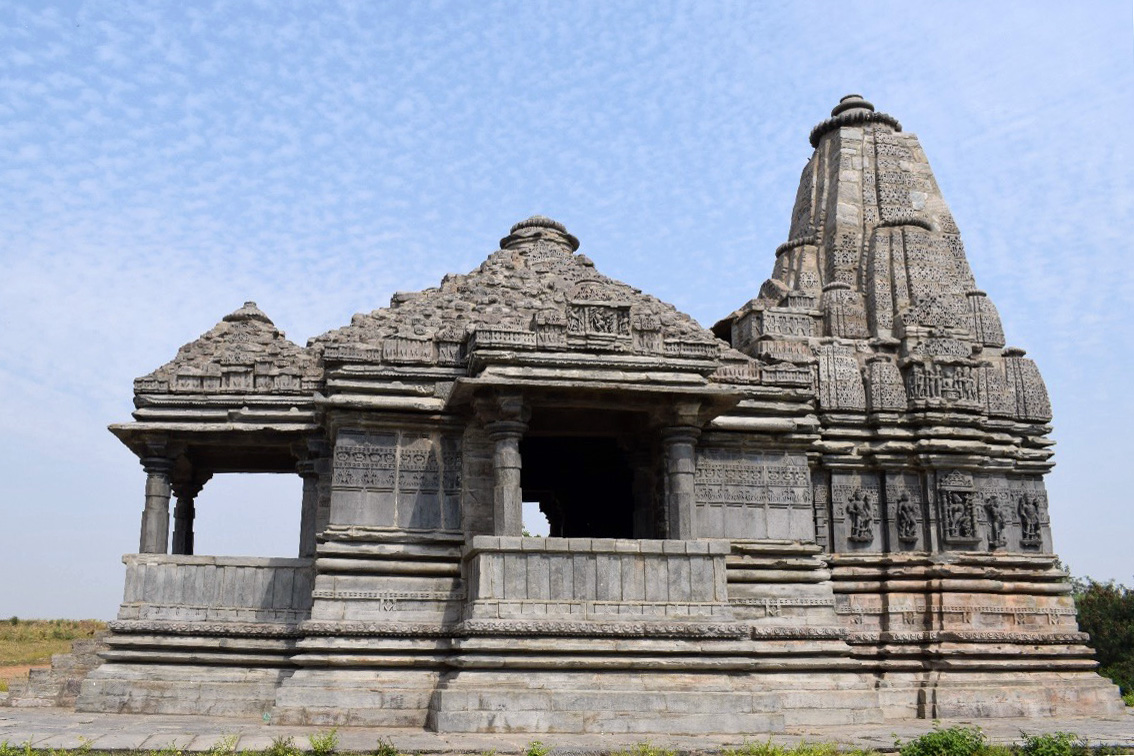
Jain Temple
The Jain Temple complex is located south of the Someshwar and Kumbheshwar Mahadev Temple complexes. Based on the extensive remains and layout, it is likely that the Jain Temple was once a large complex. Like other temples in Arthuna, this temple stands on an elevated platform, accessible through a flight of steps on the north side. A Jinalaya, or Jain temple, refers to its main shrine as a jinaprasada. Plinths on its three sides surround this main temple, supporting small shrines known as devakulikas. Square in design, only a couple of such small shrines remain today, but they likely surrounded the main temple in the past, functioning as small shrines to enshrine deities or as places of worship for ascetics and monks.
The main temple is of a pancharatha variety, i.e., each exterior wall of the mulaprasada possesses five projections. The plinth that supports the jangha (exterior wall) consists of conventional mouldings of khura, kumbha, and kalasha with sharp shapes and edges but minimal embellishments. The recessed and projected jangha surfaces are home to a variety of images. The principal niches are empty today; however, other projections have dikpalas, complemented with the images of apsaras and ascetics. The corner aedicules known as pratyangas preserve the shekhari-shikhara, but the main central spire has vanished. Interestingly, the niches at each side of the shikhara’s base contain images of goddesses Lakshmi, Chakreshvari, and Brahmani on the east, south, and west sides, respectively. This is a distinctive feature of the temple. The shrine's interior door jamb features an image of a Jina, indicating the temple's former devotion to Jain worship. Due to a heavy bat infestation, the interiors of the mandapa and garbhagriha are not easily accessible.
Several remnants of numerous other shrines, possibly part of a larger complex, can be found to the west of the main temple. Most of the superstructure is dilapidated, with dismantled portions visible near the temple. The only notable remnants are the mutilated colossal images of Jina, a rarity among free-standing Jina images. This is a Jain Tirthankara image from the Alwar district in the Neelkanth Mahadev Temple complex. The inscriptions at the base of the free-standing statues date back to the sixteenth century CE. Scholars argue that the extant temple, whose original construction dates back to the twelfth century CE, underwent restorations in the fifteenth to sixteenth centuries CE, based on the re-modelling of its interiors. [12]
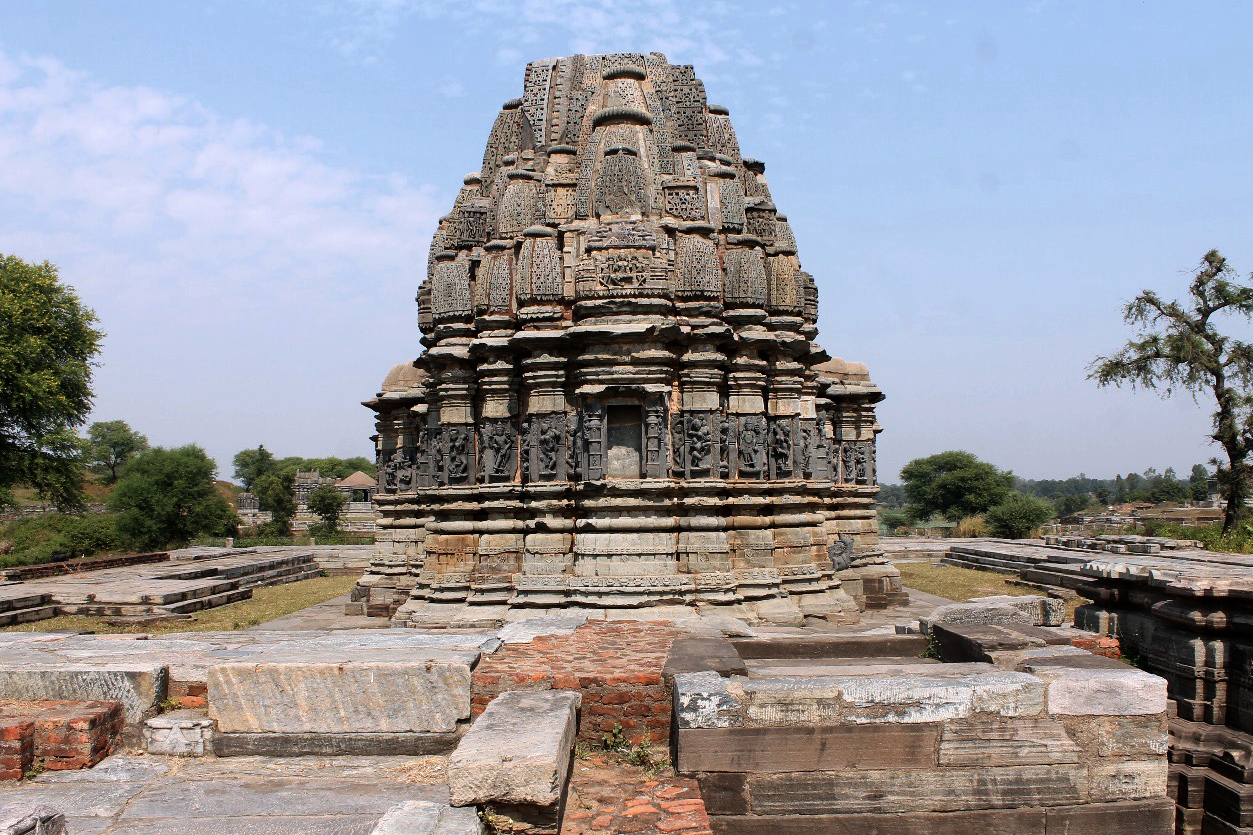
Chaunsath Yogini Temple
Another important temple in Arthuna is the Chaunsath Yogini Temple, located a bit further from the Jain Temple. It is one of the site's most beautiful temples, despite being in ruins. In terms of ground plan and elevation, the Chaunsath Yogini Temple follows the conventions of most other temples in Arthuna. It stands on a jagati consisting of a garbhagriha, mandapa, and a mukhamandapa. A bejewelled exterior wall has preserved the garbhagriha, but a significant portion of the mandapa has vanished. The temple's conjectural plan is discernible from what remains in the form of plinth traces and masonry ruins, the conjectural plan of the temple is discernible. The vedibandha of the temple is quite different from other temples in Arthuna, which consists of finely carved mouldings like gajathara (a band of elephants), narathara (a band of human figures), kumbha, and kalasha. The gajathara and narathara mouldings are unique to this temple in Arthuna. Although the kumbha and kalasha mouldings are found in other temples like Someshwar and Kumbheshwar Mahadev, the surface treatment of these mouldings in the Chaunsath Yogini Temple is distinct.
The three principal niches facing the cardinal directions on the exterior walls of this temple are empty. However, the images on subsidiary projections, such as those at the base of the shikhara and on the kumbha moulding of the vedibandha, suggest the temple's dedication to Goddess worship. This is the only temple in Arthuna that exhibits a shakta affiliation; all other temples are Shaiva or Jain.
Other Architectural Remains within Arthuna
Apart from the temples discussed above, there are ruins of many other temples scattered around the lake. The ASI has demarcated the plinths within the enclosure walls of some ruinous structures. These ruinous plinths are located next to the Someshwar Mahadev Temple, the Shiva Temple, and the Hanuman Garhi Temple. The plinth remains near the Hanuman Garhi Temple complex and stylistically aligns with other temple architecture patterns at Arthuna. These remnants bear witness to the existence of numerous other temples that have vanished over time.
The temples of Arthuna, nestled in a small village and testament to the rules of a relatively smaller dynasty, are an important historical record of the region and a marker of architectural exuberance. However, the temples of Arthuna do not receive the attention they deserve in both academic and popular discussions. For better preservation of the ruins and a nuanced understanding of their art-architectural merit, the edifices at Arthuna need to be visited, studied, and discussed in greater detail.
Footnotes:
[1] Pal, The Temples of Rajasthan, 59–61.
[2] Singh, ‘Interpreting the History of the Paramāras,’ 13–14.
[3] Trivedi, Inscriptions of the Paramāras, Chandēllas, Kachchapaghātas, and Two Minor Dynasties, 289.
[4] Trivedi, Art Traditions of the Paramaras of Vagada, 1.
[5] Mehta, Political History of Gujarat C.A.D 750-950, 138–43.
[6] Trivedi, 288–89.
[7] Dhaky, ‘Renaissance and the Late Maru-Gurjara Temple Architecture,’ 8.
[8] Kielhorn, ‘Miscelleanea-A short account of six unpublished inscriptions,’ 80–81.
[9] Trivedi, Art Traditions of the Paramaras of Vagada, 39.
[10] Trivedi, Inscriptions of the Paramāras, Chandēllas, Kachchapaghātas, and Two Minor Dynasties, 309–11.
[11] Trivedi, Art Traditions of the Paramaras of Vagada, 134.
[12] Trivedi, Art Traditions of the Paramaras, 71.
Bibliography:
Dhaky, M.A. ‘Renaissance and the Late Maru-Gurjara Temple Architecture.’ Journal of the Indian Society of Oriental Art, Special Number, Western Indian Art (1965-66), 1966, 4–22.
Kielhorn, F. ‘Miscelleanea-A short account of six unpublished inscriptions.’ Edited by Richard Carnac Temple. Oriental Research Institute Bombay, The Indian Antiquary A Journal of Oriental Research, no. XXII (1893): 80–81.
Mehta, Shobhana K. Political History of Gujarat C.A.D 750-950. University of London, School of Oriental and African Studies (United Kingdom), 1961.
Pal, Hamendar Bhisham. The Temples of Rajasthan. Prakash Publishers, 1969.
Singh, Arvind K. ‘Interpreting the History of the Paramāras’. In Journal of the Royal Asiatic Society 22, no. 1 (2012): 13–28.
Trivedi, H. V. Inscriptions of the Paramāras, Chandēllas, Kachchapaghātas, and Two Minor Dynasties. Corpus Inscriptionum Indicarum. Archaeological Survey of India, 1900.
Trivedi, P. K. Art Traditions of the Paramaras of Vagada. Jaipur Publication Scheme, 1995.
